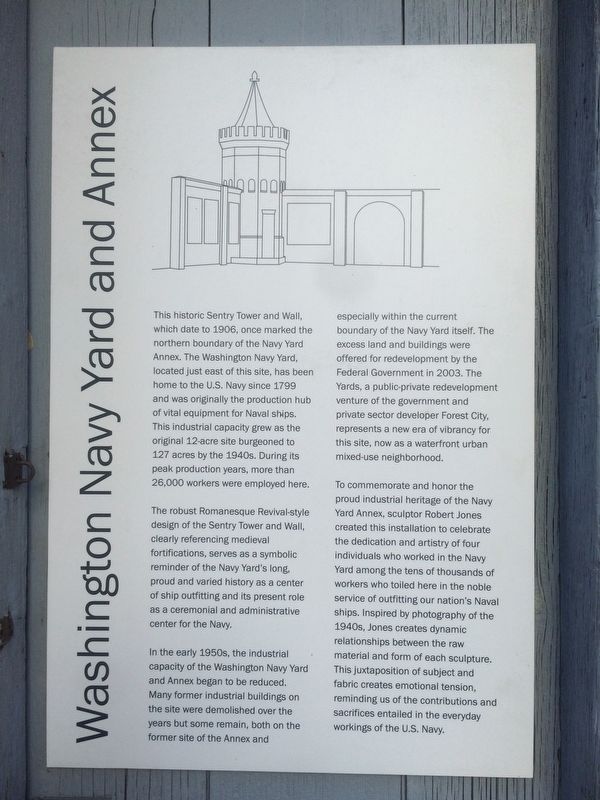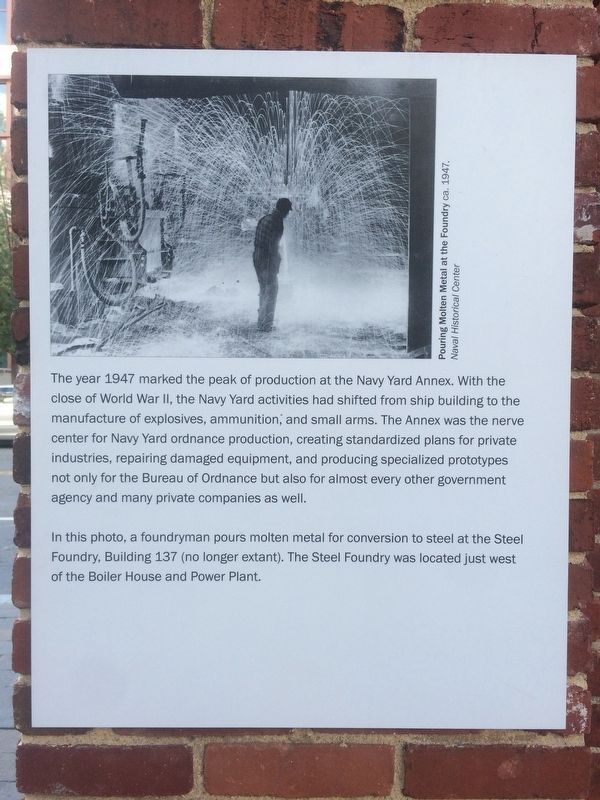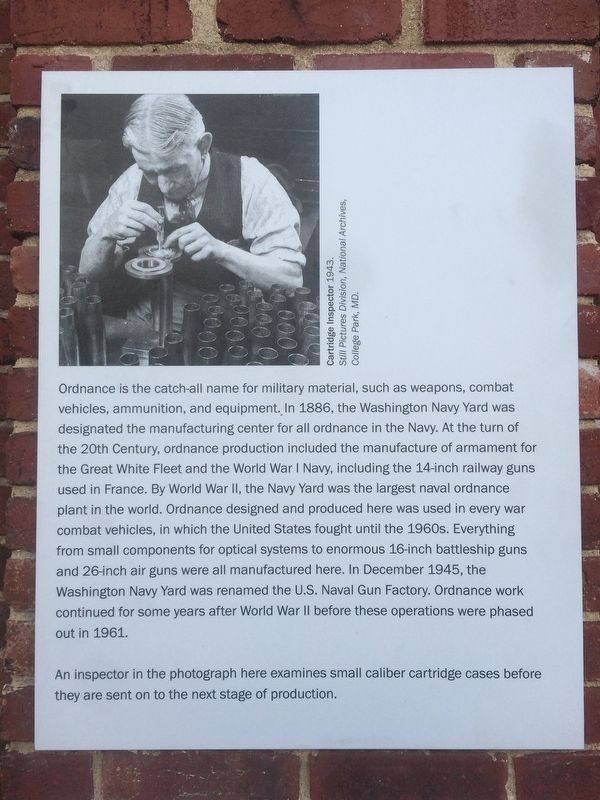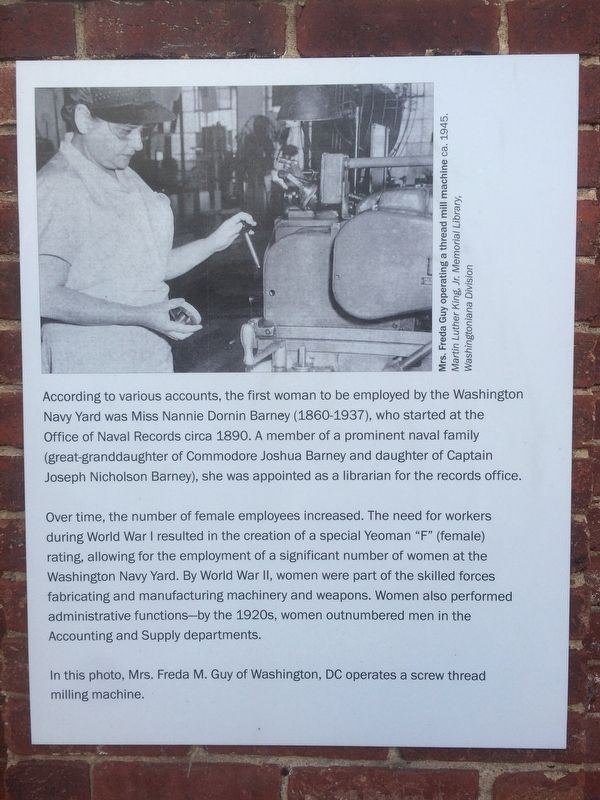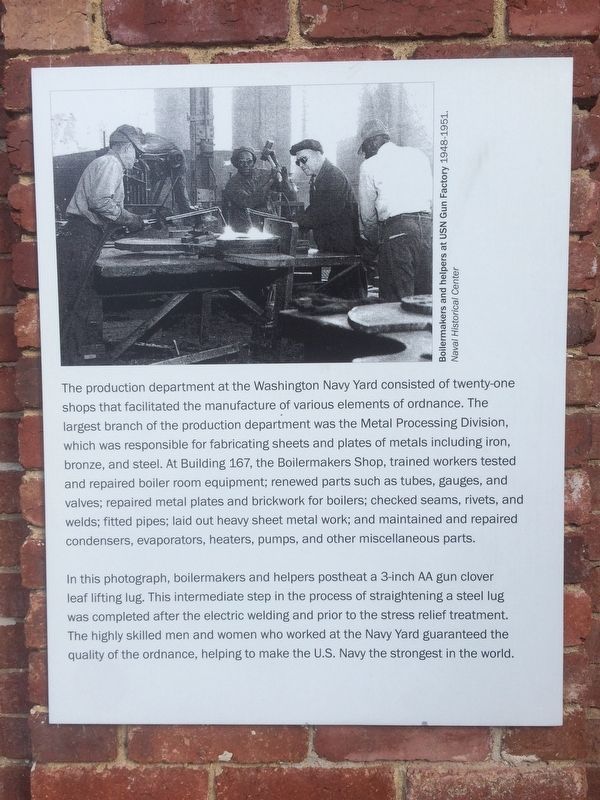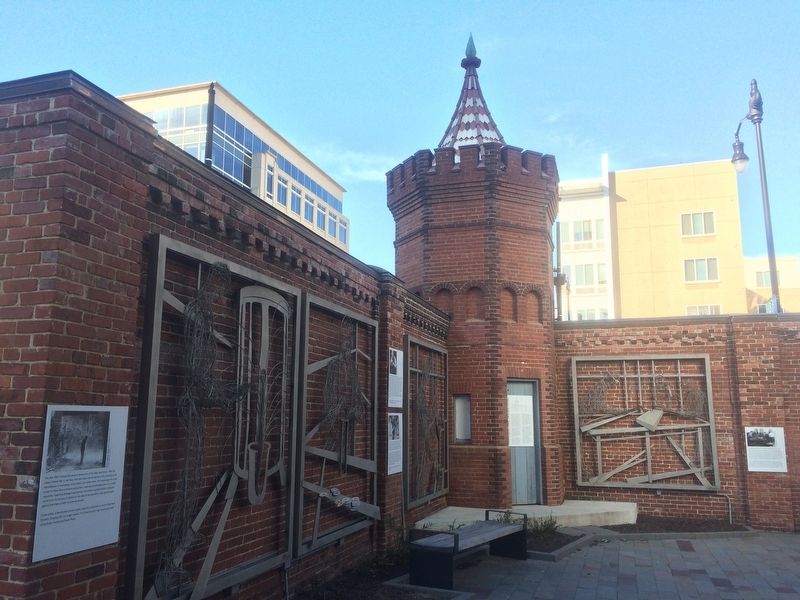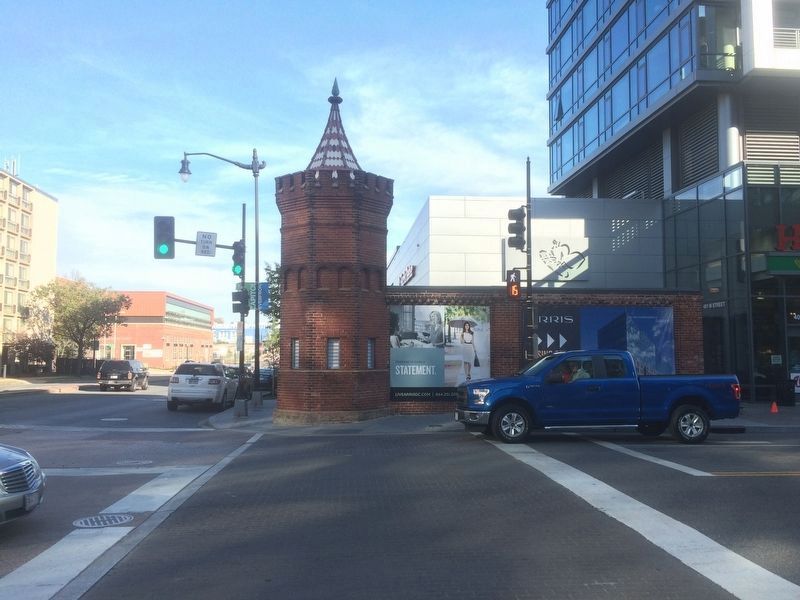Navy Yard in Southeast Washington in Washington, District of Columbia — The American Northeast (Mid-Atlantic)
Washington Navy Yard and Annex
Sentry Tower and Walls
This marker is made up of five separate panels.
This historic Sentry Tower and Wall, which date to 1906, once marked the northern boundary of the Navy Yard Annex. The Washington Navy Yard, located just east of this site, has been home to the U.S. Navy since 1799 and was originally the production hub of vital equipment for Naval ships. This industrial capacity grew as the original 12-acre site burgeoned to 127 acres by the 1940s. During its peak production years, more than 26,000 workers were employed here.
The robust Romanesque Revival-style design of the Sentry Tower and Wall, clearly referencing medieval fortifications, serves as a symbolic reminder of the Navy Yard’s long, proud and varied history as a center of ship outfitting and its present role as a ceremonial and administrative center for the Navy.
In the early 1950s, the industrial capacity of the Washington Navy Yard and Annex began to be reduced. Many former industrial buildings on the site were demolished over the years but some remain, both on the former site of the Annex and especially within the current boundary of the Navy Yard itself. The excess land and buildings were offered for redevelopment by the Federal Government in 2003. The Yards, a public-private redevelopment venture of the government and private sector developer Forest City, represents a new era of vibrancy for this site, now as a waterfront urban mixed-use neighborhood.
To commemorate and honor the proud industrial heritage of the Navy Yard Annex, sculptor Robert Jones created this installation to celebrate the dedication and artistry of four individuals who worked in the Navy Yard among the tens of thousands of workers who toiled here in the noble service of outfitting our nation’s Naval ships. Inspired by photography of the 1940s, Jones creates dynamic relationships between the raw material and form of each sculpture. The juxtaposition of subject and fabric creates emotional tension, reminding us of the contributions and sacrifices entailed in the everyday workings of the U.S. Navy.
The year 1947 marked the peak production at the Navy Yard Annex. With the close of World War II, the Navy Yard activities had shifted from ship building to the manufacture of explosives, ammunition, and small arms. The Annex was the nerve center for Navy Yard ordnance production, creating standardized plans for private industries, repairing damaged equipment, and producing specialized prototypes not only for the Bureau of Ordnance but also for almost every other government agency and many private companies as well.
In this photo, a foundryman pours molten for conversion to steel at the Steel Foundry, Building 137 (no longer extant). The Steel Foundry was located just west of the Boiler House and Power Plant.
Pouring Molten Metal at the Foundry ca. 1947.
Naval Historical Center
Ordnance is the catch-all name for military material, such as weapons, combat vehicles, ammunition, and equipment. In 1886, the Washington Navy Yard was designated the manufacturing center for all ordnance in the Navy. At the turn of the 20th Century, ordnance production included the manufacture of armament for the Great White Fleet and the World War I Navy, including the 14-inch railway guns used in France. By World War II, the Navy Yard was the largest naval ordnance plant in the world. Ordnance designed and produced here was used in every war combat vehicles, in which the United States fought until the 1960s. Everything from small components for optical systems to enormous 16-inch battleship guns and 26-inch air guns were all manufactured here. In December 1945, the Washington Navy Yard was renamed the U.S. Naval Gun Factory. Ordnance work continued for some years after World War II before these operations were phased out in 1961.
An inspector in the photograph here examines small caliber cartridge cases before they are sent on to the next stage of production.
Cartridge Inspector 1943.
Still Pictures Division, National Archives, College Park, MD.
According to various accounts, the first woman to be employed by the Washington Navy Yard was Miss Nannie Dornin Barney (1860-1937), who started at the Office of Naval Records circa 1890. A member of a prominent naval family (great-granddaughter of Commodore Joshua Barney and daughter of Captain Joseph Nicholson Barney), she was appointed as a librarian for the records office.
Over time, the number of female employees increased. The need for workers during World War I resulted in the creation of a special Yeoman “F” (female) rating, allowing for the employment of a significant number of women at the Washington Navy Yard. By World War II, women were part of the skilled forces fabricating and manufacturing machinery and weapons. Women also performed administrative functions – by the 1920s, women outnumbered men in the Accounting and Supply departments.
In this photo Mrs. Freda M. Guy of Washington, DC operates a screw thread milling machine.
Mrs. Freda Guy operating a thread mill machine ca. 1945.
Martin Luther King, Jr. Memorial Library, Washingtoniana Division
The production department at the Washington Navy Yard consisted of twenty-one shops that facilitated the manufacture of various elements of ordnance. The largest branch of the production department was the Metal Processing Division, which was responsible for fabricating sheets and plates of metals including iron, bronze, and steel. At Building 167, the Boilermakers Shop, trained workers tested and repaired boiler room equipment; renewed parts such as tubes, gauges, and valves; repaired metal plates and brickwork for boilers; checked seams, rivets, and welds; fitted pipes, laid out heavy sheet metal work; and maintained and repaired condensers, evaporators, heaters, pumps, and other miscellaneous parts.
In this photograph, boilermakers and helpers postheat a 3-inch AA gun clover leaf lifting lug. This intermediate step in the process of straightening a steel lug was completed after the electric welding and prior to the stress relief treatment. The highly skilled men and women who worked at the Navy Yard guaranteed the quality of the ordnance, helping to make the U.S. Naval the strongest in the world.
Boilermakers and helpers at USN Gun Factory 1948-1951.
Naval Historical Center
Topics. This historical marker is listed in this topic list: Military. A significant historical month for this entry is December 1945.
Location. 38° 52.58′ N, 77° 0.025′ W. Marker is in Southeast Washington in Washington, District of Columbia. It is in Navy Yard. Marker can be reached from the intersection of M Street Southeast and 4th Street Southeast, on the right when traveling east. The markers are on the interior of the remaining wall of the Washington Navy Yard as one enters to a supermarket. Touch for map. Marker is in this post office area: Washington DC 20003, United States of America. Touch for directions.
Other nearby markers. At least 8 other markers are within walking distance of this marker. Switching Yard (within shouting distance of this marker); 1865-1869 (within shouting distance of this marker); 1830 (within shouting distance of this marker); 1817 (within shouting distance of this marker); 1840-1950 (within shouting distance of this marker); a different marker also named 1830 (within shouting distance of this marker); 1825 (within shouting distance of this marker); 1827 (within shouting distance of this marker). Touch for a list and map of all markers in Southeast Washington.
Credits. This page was last revised on January 30, 2023. It was originally submitted on December 3, 2016, by J. Makali Bruton of Accra, Ghana. This page has been viewed 692 times since then and 49 times this year. Photos: 1, 2, 3, 4, 5, 6, 7. submitted on December 3, 2016, by J. Makali Bruton of Accra, Ghana.
